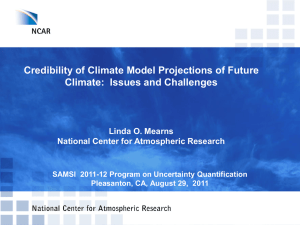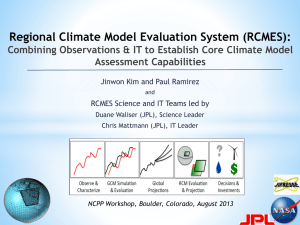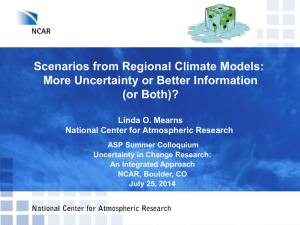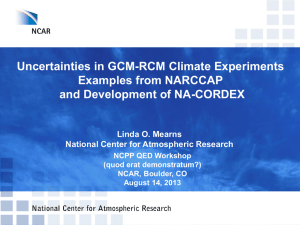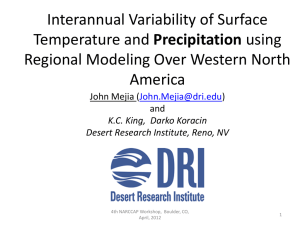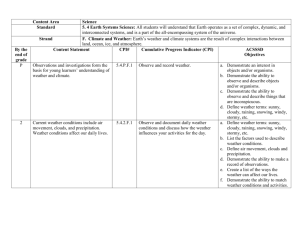FINALNARCCAPabstracts
advertisement
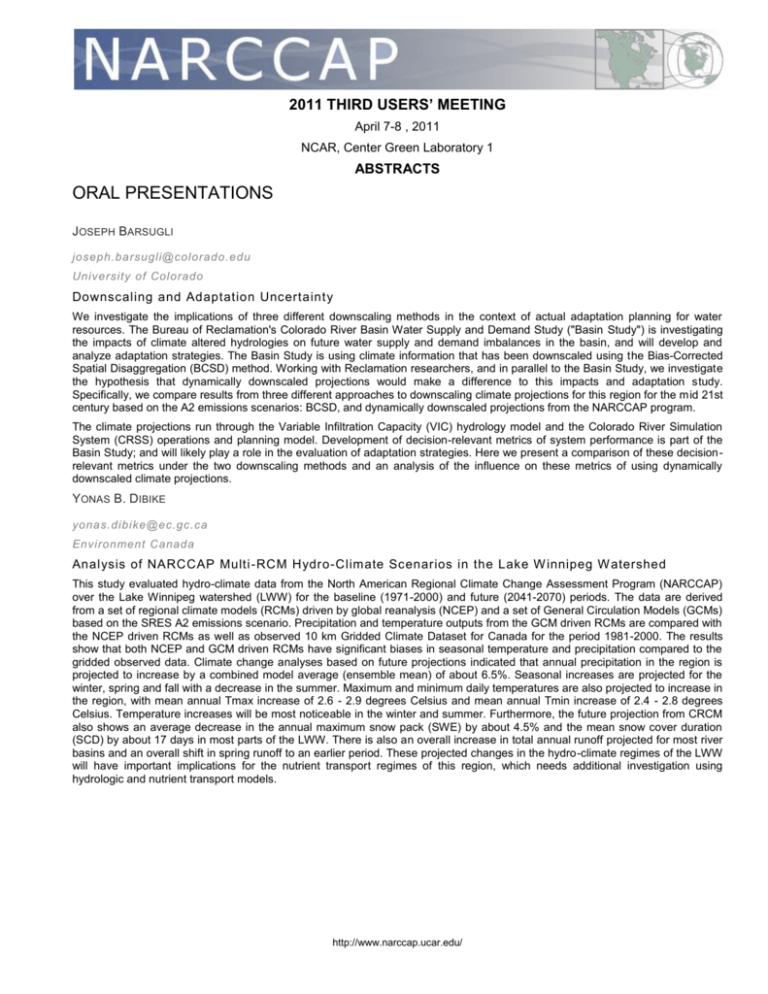
2011 THIRD USERS’ MEETING April 7-8 , 2011 NCAR, Center Green Laboratory 1 ABSTRACTS ORAL PRESENTATIONS J OSEPH BARSUGLI joseph.barsugli@colorado.edu University of Colorado Downscaling and Adaptation Uncertainty We investigate the implications of three different downscaling methods in the context of actual adaptation planning for water resources. The Bureau of Reclamation's Colorado River Basin Water Supply and Demand Study ("Basin Study") is investigating the impacts of climate altered hydrologies on future water supply and demand imbalances in the basin, and will develop and analyze adaptation strategies. The Basin Study is using climate information that has been downscaled using the Bias-Corrected Spatial Disaggregation (BCSD) method. Working with Reclamation researchers, and in parallel to the Basin Study, we investigate the hypothesis that dynamically downscaled projections would make a difference to this impacts and adaptation study. Specifically, we compare results from three different approaches to downscaling climate projections for this region for the mid 21st century based on the A2 emissions scenarios: BCSD, and dynamically downscaled projections from the NARCCAP program. The climate projections run through the Variable Infiltration Capacity (VIC) hydrology model and the Colorado River Simulation System (CRSS) operations and planning model. Development of decision-relevant metrics of system performance is part of the Basin Study; and will likely play a role in the evaluation of adaptation strategies. Here we present a comparison of these decisionrelevant metrics under the two downscaling methods and an analysis of the influence on these metrics of using dynamically downscaled climate projections. YONAS B. DIBIKE yonas.dibike@ec.gc.ca Environment Canada Analysis of NARCCAP Multi-RCM Hydro-Climate Scenarios in the Lake W innipeg W atershed This study evaluated hydro-climate data from the North American Regional Climate Change Assessment Program (NARCCAP) over the Lake Winnipeg watershed (LWW) for the baseline (1971-2000) and future (2041-2070) periods. The data are derived from a set of regional climate models (RCMs) driven by global reanalysis (NCEP) and a set of General Circulation Models (GCMs) based on the SRES A2 emissions scenario. Precipitation and temperature outputs from the GCM driven RCMs are compared with the NCEP driven RCMs as well as observed 10 km Gridded Climate Dataset for Canada for the period 1981-2000. The results show that both NCEP and GCM driven RCMs have significant biases in seasonal temperature and precipitation compared to the gridded observed data. Climate change analyses based on future projections indicated that annual precipitation in the region is projected to increase by a combined model average (ensemble mean) of about 6.5%. Seasonal increases are projected for the winter, spring and fall with a decrease in the summer. Maximum and minimum daily temperatures are also projected to increase in the region, with mean annual Tmax increase of 2.6 - 2.9 degrees Celsius and mean annual Tmin increase of 2.4 - 2.8 degrees Celsius. Temperature increases will be most noticeable in the winter and summer. Furthermore, the future projection from CRCM also shows an average decrease in the annual maximum snow pack (SWE) by about 4.5% and the mean snow cover duration (SCD) by about 17 days in most parts of the LWW. There is also an overall increase in total annual runoff projected for most river basins and an overall shift in spring runoff to an earlier period. These projected changes in the hydro-climate regimes of the LWW will have important implications for the nutrient transport regimes of this region, which needs additional investigation using hydrologic and nutrient transport models. http://www.narccap.ucar.edu/ KENNETH KUNKEL ken.kunkel@noaa.gov NOAA Cooperative Institute for Climate and Satellites Use of NARCCAP in the US National Climate Assessment The National Climate Assessment is in the initial stages of preparing a report to be delivered to Congress in 2013. To support regional and sectoral evaluations of impacts, the National Climate Assessment team will be preparing physical climate projections for the nation. We plan to use the NARCCAP simulations as one component of these projections. We also plan to provide information about the fidelity of the control simulations in reproducing the present-day climate. We are very interested in contributions from the NARCCAP users’ community. I will discuss specific needs of the assessment. G UILONG LI Guilong.Li@ec.gc.ca Environment Canada In collaboration with Xuebin Zhang2and Francis Zwiers3 2 Climate Research Division, Environment Canada, Toronto, Ontario, Canada, 3 Pacific Climate Impacts Consortium, Victoria, BC, Canada Quantification of Uncertainty in High Resolution Temperature Scenarios for North America A framework for the construction of probabilistic projections of high resolution monthly temperature over North America using available outputs of opportunity from ensembles of multiple General Circulation Models (GCMs) and multiple Regional Climate Models (RCMs) is proposed. In this approach, we first established a statistical relationship between RCM output and output from the respective driving GCM. This relationship is then applied to downscale outputs from a larger number of GCM simulations. Those statistically downscaled projections were used to estimate empirical quantiles at high resolution. Uncertainty in the projected temperature was partitioned into four sources including differences in GCMs, internal variability simulated by GCMs, differences in RCMs, and statistical downscaling including internal variability at finer spatial scale. We found large spatial variability in projected future temperature changes, with increasingly larger changes towards the north in winter temperature and larger changes in the middle latitudes US in summer temperature. We also found that downscaling to small spatial scale contributes more to the uncertainty in the projected temperature changes than any other sources. KELLY MAHONEY kelly.mahoney@noaa.gov UCAR/NOAA/USBR Further Dynamical Downscaling Using W RF: High -resolution Simulations of Extreme Precipitati on Events in Future NARCCAP Climate Scenarios Dynamical downscaling of climate model data is an increasingly popular way to link potential changes in the large-scale climate pattern to discernible "weather" at regional and local scales. However, there exists a wide spectrum of possible methodologies that one may use to dynamically downscale climate data. This methodological uncertainty further complicates the fact that the utility of downscaled datasets is often limited by a lack of information regarding skill/uncertainty in the higher-resolution model output. The problem of downscaling becomes even more acute when dealing with extreme weather phenomena such as flood events, as the ability to resolve fine-scale atmospheric processes becomes critical in forming a realistic picture of future flood risk in complex terrain. This study uses the Weather Research and Forecasting (WRF) model to evaluate three dynamical downscaling methodologies for extreme precipitation events in the western US. The climate data to be downscaled are provided by NARCCAP's regional climate model simulations. The three approaches are (i) direct downscaling to 1-km grid spacing of the most extreme (i.e., top 1%) precipitation events; (ii) using extreme event composites as initial conditions in the WRF model, and (iii) a "climate perturbation" approach that modifies the initial conditions of a single extreme precipitation event by adding an "average climate change signal" to the thermodynamic fields of the original event. These three methods are compared for multiple NARCCAP GCM-RCM experiments across central and eastern Colorado, with the ultimate objective of better informing the needs of water resources managers in the western US. http://www.narccap.ucar.edu/ SETH MCGINNIS mcginnis@ucar.edu NCAR Effects of Spatia l Interpolation Algorithm Choice on Regional Climate Model Data Analysis The analysis of regional climate model (RCM) outputs frequently requires spatial interpolation of the data from the model's native grid to another set of locations: a different grid is needed for comparison with other models, a set of station locations for modeling of dependent processes or comparison with raw observations, specific points of interest for impacts studies, and so on. Different interpolation algorithms will produce results with different spatial characteristics, such as smoothness, synoptic patterning, and distribution of extremes. To explore the importance of these differences in the NARCCAP context, we regrid model output from six different RCMs driven with NCEP boundary conditions using several interpolation methods of varying mathematical sophistication: nearest-neighbor, bilinear, inverse-distance weighting, and thin-plate spline interpolation. For each algorithm, the results are compared with observations, driving data, and source model data to determine what the magnitude of the artifacts due to interpolation is and whether these effects are likely to be significant for inter-model comparison, impacts modeling and analysis, and other uses popular in the NARCCAP community. PHIL MOREFIELD morefield.philip@epa.gov U.S. Environmental Protection Agency Utilizing NARCCAP for Assessing Hydrologic Impacts of Climate Change: Methodologies, Tools, and Challenges The U.S. EPA's Global Change Research Program has begun an effort, based on watershed modeling in 20 large U.S. watersheds, aimed at addressing gaps in our knowledge of the potential sensitivity of U.S. stream flow and nutrient and sediment loading to climate change across a broad range of scientifically plausible mid-21st Century climate futures and the methodological challenges associated with integrating existing tools (e.g., climate models, land-use models, watershed models) and datasets to address these scientific questions. The purpose of this paper is to describe the overall structure of this ongoing effort - our methods, sites, models, and scenarios - as well as discuss preliminary results generated to date for a subset of the watersheds. Specifically, we review a representative set of modeling results that encompass the full suite of sensitivity tests we are exploring in this project. These results illustrate a number of key methodological issues, sensitivities, and uncertainties associated with carrying out these types of climate change-hydrologic impacts assessments, including: the sensitivity of simulated changes to the watershed model used, the sensitivity of simulated changes to climate model and downscaling approach used, and the interaction between climate change and other key forcing factors-specifically urbanization and change in atmospheric CO2 concentration. In addition, this suite of results provides an overview of the response to climate change in different geographic regions and the different sensitivities of a variety of flow and water quality endpoints. T REVOR MURDOCK tmurdock@uvic.ca Pacific Climate Impacts Consortium Analysis of NARCCAP Results for the Pacific Northwest Regional Climate Model (RCM) projections from the North American Regional Climate Change Assessment Program (NARCCAP) and from Ouranos Consortium have been analyzed over Pacific North America. Preliminary findings include skill of each RCM to reproduce general features of temperature and precipitation climatology over the region under large scale forcing at the boundaries by observations (NCEP2 reanalysis). In comparison to Global Climate Models, RCM results are in much better agreement with historical observations. In particular, the effects of complex topography on precipitation (windward and rain shadow areas) are much improved, as is the ability to capture the effects of elevation on temperature. At the sub-regional scale, however, large differences exist between models. The differences are explored and compared to observations by focusing in on the northern Columbia River Basin. Informed by the results of this comparison, RCM projections of future climate and hydrologic change are shown for the region. Finally, an analysis of extremes was conducted in collaboration with users (Columbia Basin Trust, Engineers Canada, and communities in the Columbia Basin). Projections of extremes inform vulnerability assessments of community infrastructure and adaptation planning. http://www.narccap.ucar.edu/ MARTIN J OSE MONTERO-MARTINEZ mmontero@tlaloc.imta.mx Mexican Institute of Water Technology Validation of different NARCCAP -RCMs in the southern part of the domain NARCCAP is certainly contributing a lot to the investigation of uncertainties in regional scale projections of future climate via dynamical downscaling. It is for sure that the CGCM-RCM nudging process is going to drive more uncertainty than the CGCM simulation alone. However, before studying the CGCM-RCM simulations, this work proposes first to look at the NCEP-RCMs simulations provided by the NARCCAP website. A comparison among the different NCEP-RCMs simulations versus Climatic Research Unit (CRU) data for precipitation and surface temperature on the southern part of the domain is performed here. Different statistical simple products such as bias, correlation, and temporal trends are realized for both variables during the 19812000 period. The results seem to support the fact that it could be just as sensitive to choose any of the different RCMs evaluated here than to choose any input data from the CGCMs for the regional projections. G EORGE PAUL gpaul@ksu.edu Kansas State University Impacts of Climate Change on Crop Production in the Ogallala Aquifer Future cropping systems depend on how the future climate unfolds. The objectives of this study were: (a) to analyze climate variability and change resulting from greenhouse gas emissions using high resolution regional climate model (RCM); and (b) to determine its impact on the crop production in the Ogallala aquifer region and analyze adaptation/mitigation strategies. Three RCM's used in this study were Canadian Regional Climate Model (CRCM), Regional Climate Model (RegCM3) and the Hadley Regional Model (HRM3). The A2 climate scenario for historic period (1971-2000) and future (2041-2070) were acquired from North American Regional Climate Change Assessment Program (NARCCAP). Spatial crop modeling was performed in AEGIS/WIN 4.0.2 program available in the DSSAT (Decision Support System for Agrotechnology Transfer) crop simulation model suite. The A2 climate scenario showed variable spatial pattern and magnitude across the Ogallala region with extreme climate conditions during the cropping season. Analyses showed that Ogallala region will experience 4-5 degrees Celsius increase in the maximum temperature for the month of July and August. In addition, rainfall distribution will be highly variable. Simulation results of future climates predicted ~30% decrease in the yield of grain sorghum. However, a substantial increase in wheat production throughout the region with an average increase of ~35% was predicted in future climates. Crop management decision, effects of elevated carbon dioxide and changes in genetics were analyzed as adaptation / mitigation options for improving productivity and decreasing yield losses. Based on our results, agronomists, breeder managers, and water managers can formulate or modify their programs to target the requirements of future climate, water, and food security. SARA C. PRYOR spryor@indiana.edu Indiana University Changes in W ind Energy Resources The energy sector comprises approximately two-thirds of global total greenhouse gas emissions. For this, and other reasons, it has been the target of efforts focused on climate change mitigation. However, the energy sector is also vulnerable to potential enhancement of the risk posed by regional manifestations of global climate change. I will present analyses of the NARCCAP simulations focused on two key questions; (i) Is there evidence of a change in the wind energy resource that might impact (either negatively or positively) the viability of the wind energy industry? and (ii) Is there evidence for a change in extreme wind speeds that might impact the energy sector? I will discuss the methods used to address these questions, and the responses that can be derived using the NARCCAP output. Specifically I will show that based on analyses of the NARCCAP model suite, at least for the next 50-years, the wind resource in the regions of greatest wind energy penetration will not move beyond the historical envelope of variability. There is some weak evidence for an increase in extreme wind speeds and gusts, but again, the climate change signal is of comparable magnitude to projection uncertainty and the internal variability. I will conclude by discussing methods to reduce uncertainty and to evaluating pro-active adaptation measures. http://www.narccap.ucar.edu/ LEI QIAO leiqiao1981@gmail.com Saint Louis University Bias-adjusting CRCM-CGCM3 data and its application in the SW AT modeling of lower Missouri River Basin The study applies NARCCAP downscaling climate data to Soil and Water Assessment Tool (SWAT) hydrological model in the lower Missouri River basin. The goal is to reduce the biases between the climate model generated and the observed atmospheric driving forces for improving the confidence in evaluating climate change impacts on the flood-prone region. MICHAEL W EHNER mfwehner@lbl.gov Lawrence Berkeley National Laboratory Very extreme seasonal precipitation in the NARCCAP ensemble: Model performance and projections Extreme daily precipitation is analyzed in terms of seasonal twenty-year return values from the ensemble of NARCAPP regional climate models. Significant variation in the models' abilities to reproduce this observed precipitation statistic is found. In addition to substantial biases, the replication of the seasonal cycle of these rare events proves problematic for most of the models, particularly over the southeastern US. The implications for the projection of future changes in seasonal precipitation are discussed. POSTERS CHRIS ANDERSON cjames@iastate.edu Iowa State University Poster #1 Using NARCCAP data to Quantif y Uncertainty in Climate Sensitivity Analysis of Resour ce Management in Midwest Rivers NARCCAP data are being used in uncertainty analysis for potential impacts of climate change on management of river systems. Two examples will be given in the poster. The first example shows how NARCCAP data are being connected to probabilistic sturgeon population models through a series of hydrology models. The emphasis of this work is quantifying uncertainty in each step of the linking of models. The second example shows how the spread of watershed-scale data from NARCCAP compares with GCMs, and the types of daily data that are useful in examining potential considerations for Midwest reservoir management, particularly for flood management. Poster #2 Are non-hydrostatic dynamics necessary in climate simulations of Midwest convective systems? The debate of what climate model resolution is necessary for impacts analysis is often cast in terms of distance between grid points (i.e., is 50-km grid spacing more useful than 150-km grid spacing). This poster presents an alternative view from an experiment that asks whether non-hydrostatic dynamics, which typically become apparent at grid spacing between 10 and 20 km, are important to warm-season simulation in the Midwest. The experiment compares 12-km simulations with hydrostatic and nonhydrostatic simulations. The results may have implications for a second round of NARCCAP-like projections. DANIEL BARRIE daniel.barrie@noaa.gov NOAA In economic analyses of wind energy, wind farm projects are assumed to have lifetimes on the order of 20 to 30 years. A particular site may host a wind farm for longer than this period with refurbished or replaced turbines. Over these decadal time scales, the impact of anthropogenic global warming (AGW) on wind patterns could affect the economic viability of the wind resource in a particular location, increasing or decreasing a project's energy yield. To study the potential impacts of AGW on the wind resource, we have utilized climate model output from the North American Regional Climate Change Assessment Program's regional-scale modeling of projected climate change impacts within the United States. The predicted changes show strong dependence on both the details of the parameterizations in the regional models (e.g. roughness length data sets) as well as strong dependence on the differences in large-scale stationary and transient wave phenomena derived in part from the GCM-forced boundary conditions. We will present findings derived from this data set regarding changes in the domestic wind resource, as well as a discussion of the mechanisms responsible for the observed changes. http://www.narccap.ucar.edu/ MELISSA S. BUKOVSKY AND LINDA O. MEARNS bukovsky@ucar.edu, lindam@ucar.edu NCAR/IMAGe Late 20th Centur y Temperature Trends in the NARCCAP Regional Model Simulations In this study we will analyze simulations from the North American Regional Climate Change Assessment Program (NARCCAP) in terms of their ability to reproduce the 2-m temperature trends of the late 20th century over North America. Trends will be compared to the driving reanalysis (the NCEP-DOE global reanalysis II: R2) as well as multiple observation-based datasets for 1980-2004. Likewise, available global climate model (GCM) driven NARCCAP simulations will be examined relative to their drivers and observations from roughly 1970-1999 and compared to their reanalysis driven counterparts. We will also explain some large discrepancies in the regional climate model (RCMs) trends. Current work indicates that some biases in trend are due to model drift. Differences in trends will be discussed in the context of current regional responses to greenhouse warming, implications for bias correction, and uncertainty in future climate projections. Summertime in the NARCCAP Regional Climate Simulations This study investigates the performance of the different NARCCAP regional models as driven by the NCEP Reanalysis II for JuneAugust (JJA) from roughly 1980-2000, with a focus on central U.S. precipitation. The North American Regional Reanalysis is used for comparison to present day conditions. Also included is a brief assessment of changes in precipitation between 1971-2000 and 2041-2070 from 3 of the NARCCAP RCMs driven by 3 GCMs: the United Kingdom Hadley Centre Climate Model version 3 (HADCM), the Geophysical Fluid Dynamics Laboratory Climate Model version 2.1 (GFDL), and the Canadian Global Climate Model version 3 (CGCM). All GCMs have been forced with the SRES A2 emissions scenario for the 21st century. MELISSA S. BUKOVSKY *, DAVID J. GOCHIS ** AND LINDA O. MEARNS * NCAR/IMAGe*/RAL** NARCCAP Regional Climate Model Simulations of the North American Monsoon This study focuses on an assessment of the processes related to and the characteristics of the North American Monsoon system from Arizona and New Mexico, southward over Northern Mexico and the Gulf of California in both reanalysis and GCM driven NARCCAP simulations. At a 50-km resolution, better defined topographic, coastline and land cover features should impart better representation of many key aspects of the NAM climate system such as land-sea breezes, convective circulations and land surface heterogeneity. Thus, we will focus on more than just the characteristics of precipitation in the simulations, but also the physical and dynamical processes behind it. We will quantify some of the important characteristics of precipitation (e.g. spatial distribution, frequency, time of onset, and diurnal cycle), but additional processes, such as land surface fluxes, land-sea breezes, convective circulations and moisture flux patterns will be examined in an attempt to define the credibility of the model’s projections of future precipitation through more than just their ability to simulate the characteristics of precipitation. W EI CHU wchu2@uci.edu University of California, Irvine The spatial distribution of precipitation is very important for water planning over the western United States, where vast man-made infrastructures, such as the Central Valley Project and California Water Project, were built to resolve the mismatch between where precipitation falls and where water is consumed. Recently, Empirical Orthogonal Function (EOF) analysis on the U.S. daily precipitation product of Climate Prediction Center (CPC) revealed that there exist dominant spatial patterns in the precipitation field over the western United States. The spatial patterns are consistent at different spatial resolutions and persistent over decades. The motivation of this study is to evaluate how well dynamical downscaling can capture the spatial patterns of observed precipitation in this region. EOF analysis is applied to precipitation outputs from NARRCAP and the derived spatial patterns are compared with those of observation for the same time period. Moreover, based on model simulations, the spatial patterns of current (1971-2000) and future (2041-2070) with the SRES A2 emissions scenario are compared. The result provides insight into the impact of climate change on the spatial distribution of precipitation, which is helpful to designing adaptation strategies in the western states. This work is our first step towards the development of accurate future precipitation projection for hydrological applications. Based on the skills of simulating the spatial patterns, an ensemble of future precipitation projections from NARRCAP output will be produced. http://www.narccap.ucar.edu/ BILL FORSEE bill.forsee@dri.edu Desert Research Institute Design storm intensities, used in engineering design, are calculated from seven NARCCAP data sets using the Generalized Extreme Value distribution and regional frequency analysis for seven different metropolitan areas in the continental United States. Precipitation intensities for durations from three to 96 hours for a range of frequencies (e.g. 100-year) were calculated from NARCCAP historical simulations and future projections, and NCEP/NCAR North American Regional Reanalysis data. Design storm values from Reanalysis data and NARCCAP historical simulations were compared. Relationships between intensities from Reanalysis and NARCCAP data change substantially depending upon the location and duration; there is some clustering by NARCCAP regional climate model. Comparisons of intensities from historical simulations and future projections for most NARCCAP data sets indicate increases in design storm intensities for many locations and durations. Future work will involve using these values in watershed studies. FRANCIS GACHARI regcm4@gmail.com Jomo Kenyatta University of Agriculture and Technology Impact of Atmospheric Tides on Climate models This study assesses the role of atmospheric tidal waves in observable weather and climate changes with an inclination to extreme hydrology events. The study involves NCEP-Driven RCM Runs and Climate Change Results RCM3+GFDL as practical case studies for the purposes of understanding the processes. Diurnal and semidiurnal tidal oscillations (S1 and S2) on surface pressure will be extracted from the operational analysis product of the European Centre for Medium Range Weather Forecasting (ECMWF) Other data to be used include NCEP/NCAR Reanalysis, Palmer Drought Index, and CMAP precipitation. TRMM satellite rainfall products as well as University of East Anglia's CRU rainfall data will used to investigate the correlation between rainfall and atmospheric tides through empirical orthogonal function analysis. In this study, correlations will be investigated between SOI, IODI, TSAI indices and the temporal variability of surface pressure loading. The influence of enhanced atmospheric tides to extreme hydrology events will be investigated. Climate model simulations as well as predictions from MOHC PRECIS system and those done using the International Centre for Theoretical Physics (ICTP) Regional Climate Model version 4 (RegCM4) will be compared focusing on the advantages each model has in representing the regional climatology in terms of spatial and temporal resolution of extremes. NARCCAP simulations are necessary for providing reliable results for hypothetical case scenarios while providing an opportunity for inter-comparison of results. YANHONG GAO yanhong@hydro.washingt on.edu University of Washington We use Regional Climate Model (RCM) simulations from the North American Regional Climate Change Assessment Program (NARCCAP) to evaluate implications of climate change for the discharge of the Colorado River in the mid-21st century. We compare historical RCM simulations and simulations from their host global General Circulation Models (GCMs) to 1/8-degree gridded observations of precipitation, surface air temperature and runoff (generated by the Variable Infiltration Capacity (VIC) land surface model forced with gridded observations) for the historical period 1970-1999. The RCMs capture the primary features of observations better than their host GCMs in part because of their ability to better represent strong upward lift in topographically complex regions. Although the RCMs do not significantly improve the simulation of precipitation, their ability to better represent surface temperature in mountainous regions has important effects on simulations of evapotranspiration, snowpack, and runoff. In the Colorado River basin, the response of cold-season temperatures in headwater streams is key to determining the basin's susceptibility to a warming climate. Due to the cooler temperature and higher snow line in RCMs relative to GCMs, the RCMs project less warming in the spring and thus generate smaller decreases in runoff, both during spring and annually, as compared with GCMs. Changes in surface air temperature, runoff, and snow water equivalent at high elevations all indicate that headwater streams of the Colorado River are less susceptible to a warming climate in climate change simulations that use RCMs than in simulations that use GCMs. http://www.narccap.ucar.edu/ DORIT HAMMERLING doritmh@umich.edu University of Michigan Space-time statistical model to predic t 21st century seasonal temperature averages based on an ensemble of regional climate model runs We have developed a space-time statistical model to predict 21st century seasonal temperature averages based on an ensemble of regional climate model runs. The space-time model we developed uses observational records to assess discrepancies between the climate model runs for the time period from 1970 to 2010. Those discrepancies are then propagated into the future to obta in blended forecasts. The model features time-varying spatial heterogeneities, which allow for local comparisons of the different runs. The particular model considered is RegCM3, a regional climate model implemented by the Paleoclimate and Climate Research Group of the University of California, Santa Cruz. The different runs are based on three forcings: NCEP, GFDL and CGCM3. ERIK D. KABELA kabela@email.sc.edu University of South Carolina An inherent challenge of estimating potential climate change impacts on agriculture and water resources involves the incorporation of differing general circulation model output, and the mismatch between such output and the local scale at which impacts occur. This paper investigates dynamically downscaled regional climate model (RCM) output from the North American Regional Climate Change Assessment Program (NARCCAP) in the Southeast United States. Analysis will include assessment of RCM performance in the region during the historical period, with explanations of model bias, as well as quantification of uncertainty in future scenarios that results from differing models and downscaling methods. The focus will be on monthly temperature and precipitation changes across the region. Two NARCCAP RCMs project warming of 2-4?C for most of the Southeast U.S. by 2041-2070. Preliminary findings of projected change in July precipitation is inconclusive on the estimated magnitude and direction of precipitation change. Discrepancies in precipitation projections across the Southeast is a symptom of choice of cumulus parameterization used to form convective precipitation in the model as well as the models ability to handle tropical weather systems. Historical precipitation for the Southeast U.S. illustrates a wet bias in one RCM and a dry bias in another, further explaining discrepancies in future precipitation projections. Further analysis will incorporate future projections of additional months and RCMs from NARCCAP. A preliminary analysis of RCM skill in the historical climate will also be presented. SHO KAWAZOE shomtm62@iastate.edu Iowa State University Regional, Extreme Daily Precipitation in NARCCAP Simulations We analyze the ability of the NARCCAP ensemble of climate models to simulate extreme daily precipitation and its supporting processes for regions of North America, comparing 18 years of simulations that used observed boundary condition with observations. The analysis includes both RCM and time-slice GCM simulations using approximately half-degree resolution. We also examine extreme precipitation for one of the AOGCMs, the NCAR CCSM that contributed boundary conditions for later NARCCAP RCM simulations. Analysis focuses on an Upper Mississippi River region for winter (DJF) and summer (JJA), building on several previous analyses focused on this region. This is a region where precipitation is depends on storms generated internally by the models. In both seasons, the high resolution models generally reproduce well the precipitation-vs.-intensity spectrum seen in observations, with a small tendency toward producing overly strong precipitation at high intensity thresholds, such as the 95, 99 and 99.5 percentiles. The CCSM’s threshold values are roughly one half the magnitude of those in the models and observations, most likely because of its coarser resolution. Further analysis focuses on precipitation events exceeding the 99.5 percentile occur simultaneously at several points in the region, yielding so-called “widespread events”. Collectively, the high-resolution models also tend to produce somewhat more widespread events than the observations. Widespread events in the CCSM occur over areas of similar size, though its magnitude for the 99.5 percentile is substantially lower than for the other models. Further analysis focuses on 500 hPa flow and other fields such as humidity to compare atmospheric states and processes leading to extreme events in the models and observations. http://www.narccap.ucar.edu/ BUDONG QIAN Budong.Qian@agr.gc.ca Eastern Cereal and Oilseed Research Centre, Research Branch, Agriculture and Agri-Food Canada In collaboration with Reinder De Jong, Sam Gameda, Hong Wang, Jingyi Yang Preliminary evaluation on using direct RCM outputs in crop modeling Future climate scenarios are required as climate input to climate impact models, such as crop models, for assessing the potential impacts of climate change. It is widely accepted that downscaling is required to bridge the gap between large-scale global climate models (GCMs) and impact models. Regional Climate Models (RCMs) are often used to dynamically downscale GCM simulations to climate change information at smaller regional scale. It is also believed that direct RCM outputs could be used to drive climate impact models, especially when the spatial resolution of the RCMs becomes high. In this study, we run DSSAT crop models for common crops (spring wheat, barley, corn, soybean and potato) at seven locations (Agassiz, BC; Beaverlodge, AB; Swift Current, SK; Winnipeg, MB; London, ON; Montreal, QC; Charlottetown, PEI) across Canada. The crop simulations were performed with the same soil and crop management for a selected cultivar at a location, using observed daily climate data and daily RCM outputs at a nearby grid for the baseline period, respectively. The RCMs used in this study are CRCM driven by CGCM3 and HadRM3 driven by HadCM3, being provided by NARCCAP. Results showed that the simulated crop yields could be fairly comparable when direct RCM outputs were used to replace observed climate data, depending on which RCM and the location were used. However, localization of the RCM outputs, for example bias correction or using a stochastic weather generator, may still be required. IMTIAZ RANGWALA imtiaz.rangwala@noaa.gov NOAA, UCAR, USBR Investigating Projected W arming in the Colorado Rock y Mountains from the regional climate mod els in NARCCAP This study investigated projected seasonal changes in the minimum (Tmin) and maximum (Tmax) temperatures in the southern Colorado Rocky Mountains from several regional climate models available from NARCCAP. Sensitivity of surface elevation to the seasonal changes in these two variables was also evaluated. Analysis of the surface energy fluxes, soil moisture, specific humidity, cloud cover and surface reflectivity was performed to diagnose the projected changes in Tmin and Tmax. This analysis also included the assessment of model biases for Tmin and Tmax when forced with NCEP Reanalysis. Important findings included large Tmin increases in winter at lower elevations and large Tmax increases in summer at higher elevations. Possible mechanisms responsible for these changes will be discussed. DARRIN SHARP dsharp@coas.oregonstate.edu Oregon State University/Oregon Climate Change Research Institute The Oregon Climate Change Research Institute (OCCRI) is examining North American Regional Climate Change Assessment Program (NARCCAP) results as they apply to the Pacific Northwest domain (PNW = OR, WA, ID, AK). Five PNW “sub-domains” have been identified - Coast, Cascades, Desert, Rockies, and Yukon Flats. For each sub-domain, several NARCCAP climate parameters are being extracted, statistically processed, and visualized. For each parameter, the “current” simulation value is being compared to the “future” simulation value. The existence of multiple sub-domains within the larger study area allows for the identification of regional trends, if any, within the larger domain. Multiple NARCCAP Atmosphere-Ocean General Circulation Model (AOGCM)-Regional Climate Model (RCM) pairings are being used in an effort to better represent uncertainties. OCCRI/NARCCAP results for the PNW are also being compared to results from a similar project that used only AOGCM climate model results. The downscaled PNW NARCCAP results will be used by a variety of governmental agencies and nongovernmental organizations for climate change impacts planning, simulation, and preparation. http://www.narccap.ucar.edu/ W ILLIS SHEM shemwo@ornl.gov ORAU/ORNL A validation study of North American Regional Climate Change Assessment Program (NARCCAP) climate simulations is conducted for selected United States Forest Service (USFS) sites in the southeastern USA. Preliminary results focus on qualitative comparisons of seasonal and monthly data from NARCCAP simulations to the regional surface air temperature and precipitation data sets developed at the University of Delaware. Additional analyses extend current validation efforts to more quantitative methods incorporating seasonal and monthly time-series plots of both temperature and precipitation for the selected forest sites. These validation studies are precursors to current research to assess the vulnerability of southeastern forest cover and fire loads to climate change. Anticipated outcomes from this research will be useful for decision support and policy development by national, state, and local stakeholders. SHUANG-YE W U swu526@gmail.com University of Dayton Potential impacts of climate change on the precipitation pattern in Ohio This study uses NARCCAP models to assess the potential impacts of climate change on the precipitation pattern in Ohio. It has two main objectives. First, we evaluate the performance of NARCCAP models in terms of whether they capture (a) the spatial variations of precipitation pattern in Ohio; and (b) frequency distribution of daily precipitation data. Second, based on the evaluation, we correct the bias in mean precipitation and frequency distribution of precipitation output from RCMs. After the model biases have been corrected, we then project future changes of mean and extreme precipitation patterns in Ohio. We found that NARCCAP models reproduce spatial variations of Ohio precipitation reasonably well. Ensemble mean of all models performs better than any single model. In terms of frequency distribution of daily precipitation data, all models have biases. They typically overestimate small precipitation events and underestimate extreme precipitation. We used quantile mapping method to correct the bias in frequency distribution. Based on the bias-corrected model output, we find that on average, precipitation in Ohio will increase by 12%. The magnitudes of extreme precipitation are likely to increase more than mean. The increase will be more significant for more extreme events. Northern Ohio is likely to see more increase in both mean and extreme precipitation, which is likely due to increased evaporation from the Great Lakes. FENG ZHANG fzhang@gatech.edu Georgia Institute of Technology Comparing J oint Variable Spatial Downscaling Results with NARCCAP Datasets High resolution climate scenarios produced by the North American Regional Climate Change Assessment Program (NARCCAP) are important resources for comparing and validating statistical downscaling methods. We developed a new statistical technique for downscaling gridded climatic variables-joint variable spatial downscaling (JVSD)-to generate high resolution gridded datasets for regional watershed modeling and assessments. It differs from previous statistical downscaling methods in that multiple climatic variables are downscaled simultaneously and consistently to produce realistic climate projections. We have shown that JVSD is able to reproduce the sub-grid climatic features as well as their temporal/spatial variability in the historical periods. In order to validate the physical realistic of JVSD, we compare the JVSD results with dynamic downscaling datasets from NARCCAP for the future period 2041-2070. The full JVSD (with bias correction) and dynamic downscaling exhibit significant differences for both atmospheric fields. This combined with the favorable JVSD comparison with observed data leads to the conclusion that dynamic downscaling without some form of bias correction may not be suitable for hydrologic assessments. Such a correction could potentially be implemented using the JVSD approach. http://www.narccap.ucar.edu/
